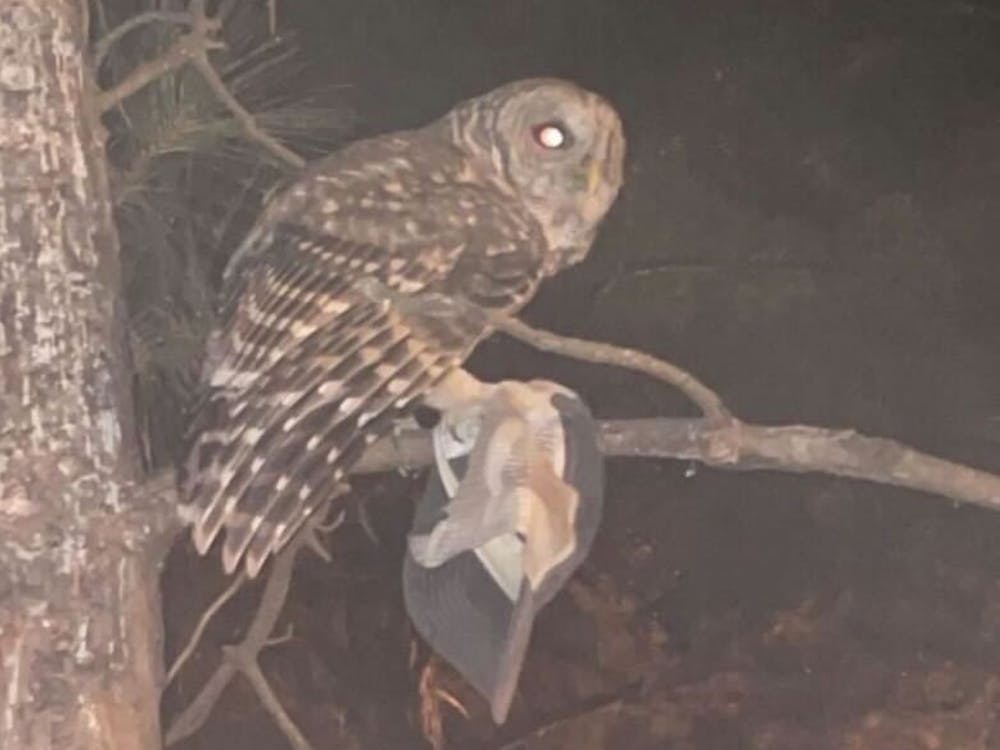Around a week before students arrived on campus, owls attacked chemistry professor Leo Leopold while he walked behind Humanities Hall around 11 p.m.
“It felt like a 10-pound pinecone hit me in the back of the head,” Leopold said.
After a few moments of questioning, he heard squawking.
“I touched the back of my head and found blood,” he said. “That was when I looked up and saw two owls.”
This was the beginning of owl attacks across campus that have brought many unsuspecting victims face to face with large yellow eyes and sharp talons.
After the incident, he found claw marks and chunks of skin missing from the back of his head: “The weirdest part was that there was zero noise,” he said. “It was shocking that something that big could make contact with me and I didn’t hear it.”
Both students and faculty have encountered the agitated animals. Incidents have occurred on both sides of Westhampton Lake between the hours of 8 p.m. and 11 p.m.
“It sounds like it’s taken over campus,” sophomore Evan Costales said.
Biology professor Peter Smallwood said the University of Richmond was dealing with a barred owl, which is common in the southern portion of the United States. Their talons kill small prey and are the second largest owl in Virginia, Smallwood said.
“This thing should be hunting rabbits, squirrels or pigeons,” Smallwood said. “That’s why this behavior is so unusual.”
An owl attacked two students on Aug. 30 near Crenshaw Field.
Costales was one of them. At around 8:45 p.m., he walked from his dorm to the parking lot behind the field.
Enjoy what you're reading?
Signup for our newsletter
“The owl came up behind me,” he said. “I didn’t hear it, and it took my hat and flew up to a nearby branch.”
After seeing the owl fly off with his hat, he continued with his night.
“I found my hat a bit later,” Costales said, “but it had holes in it from the owl’s claws.”
Costales said his hat protected him from getting clawed deep into his head and only got one minor scratch on his head.
“Watch yourself on that side of campus,” he said.
Sophomore Tyler Ferdinand was walking back from his car around 10:30 p.m. when he was knocked to the ground by what he thought was a baseball bat, he said.
After not seeing anything, Ferdinand continued to walk to his dorm, he said. Then, Ferdinand said the owl attacked the back of his head a second time.
“I thought I was getting mugged or something.” he said, “but then I looked up and saw these orange or yellowish eyes.”
Ferdinand said he believed that if the owl had hit him a third time, it would have knocked him out.
“I had a big cut on the back of my head,” he said, “and six minor cuts across my scalp. All of them scabbed over, but it hurt a lot.”
He went to the Student Health Center the next morning to get checked out, he said. They assured him he could not get rabies and got his tetanus shot updated to ensure the owl didn’t transmit anything, he said.
“You can’t hear or see it coming,” Ferdinand said. “I assume there was a nest that I was invading near those trees.”
Smallwood is working with Facilities, Public Safety and the Virginia Department of Wildlife Resources to protect the community and the bird, wrote Sunni Brown, director of media and public relations, in an email to The Collegian.
Smallwood said that while barred owls were very territorial, the owl was attacking in different areas, so it wasn’t protecting a nest. Their typical nesting period is during February and March, and the teenage owls typically leave by June or July, Smallwood said.
“This bird was probably raised in captivity and escaped,” Smallwood said. “I don’t think it’s trying to attack people. I think it’s just used to people feeding it and it’s probably really hungry.”
Birds of prey in captivity are only legal with a license to show them for educational purposes, Smallwood said.
“No one should invite this owl toward them,” he said. “If you wave at it, that should scare it off.”
Smallwood has been in contact with the Richmond Audubon Society to see if they know anyone who has a license and has lost an owl, or if they know anyone who could help UR with the owl.
“In a nature center, it could live out a decent life when others could see how magnificent these birds are,” he said.
Contact news writer Amy Jablonski at amy.jablonski@richmond.edu.
Support independent student media
You can make a tax-deductible donation by clicking the button below, which takes you to our secure PayPal account. The page is set up to receive contributions in whatever amount you designate. We look forward to using the money we raise to further our mission of providing honest and accurate information to students, faculty, staff, alumni and others in the general public.
Donate Now



